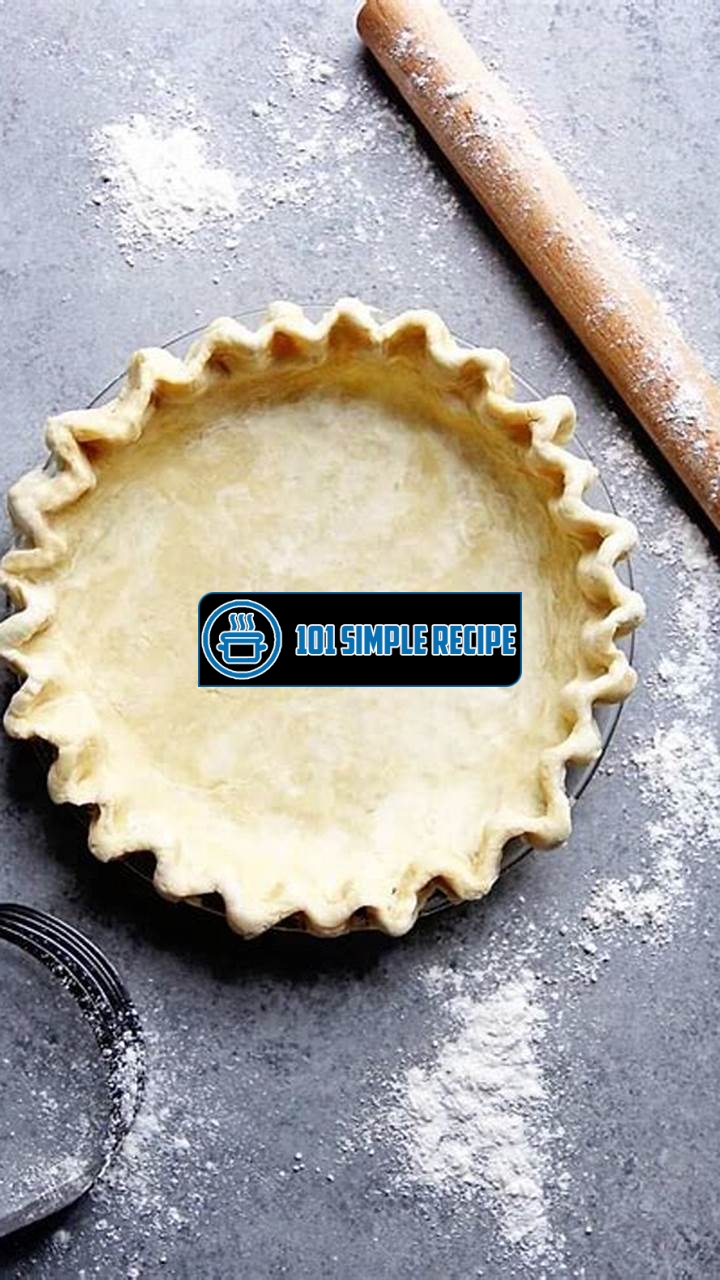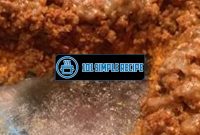Looking for an easy and delicious sweet pie crust recipe to satisfy your cravings? Look no further! Whether you’re planning a family gathering or just want to indulge in a sweet treat, this recipe is perfect for you. With just a handful of ingredients and a few simple steps, you’ll be able to create a mouthwatering pie crust that will leave you wanting more. ✨

The Essentials of a Sweet Pie Crust Recipe
A comprehensive guide detailing everything you need to know about making a delicious and easy sweet pie crust.
Pie Crust Basics
When it comes to making a sweet pie crust, there are a few key basics that you need to keep in mind. First and foremost, you’ll want to make sure you have the right tools for the job. A sturdy rolling pin and a good quality pie dish are essential. Additionally, having a food processor or a pastry cutter can make the process much easier.
Next, it’s important to understand the different types of pie crusts. Sweet pie crusts can be made with either a butter-based or a shortening-based dough. Each type has its own unique flavor and texture. Butter-based crusts tend to be more flavorful and flaky, while shortening-based crusts are known for their tenderness and ability to hold their shape.
Finally, don’t forget about the importance of chilling your dough. This step ensures that the fat in the dough is cold and solid, which results in a flaky and tender crust. It’s recommended to chill the dough for at least 30 minutes before rolling it out.
Choosing the Right Ingredients
The key to a great sweet pie crust lies in choosing the right ingredients. For a basic sweet pie crust, you’ll need all-purpose flour, salt, sugar, butter or shortening, and ice water. The flour provides structure, while the fat adds flavor and creates a tender crust. The salt and sugar enhance the flavor, and the ice water helps bind the dough together.
When it comes to selecting your fat, it’s a matter of personal preference. Butter adds a rich and flavorful taste, while shortening creates a more neutral flavor. Some bakers even choose to use a combination of both for the best of both worlds. Ultimately, the choice is yours.
It’s also worth noting that the temperature of your fat and water is crucial. The fat should be cold and firm, while the water should be ice-cold. This ensures that the fat remains solid and doesn’t melt too quickly, resulting in a flaky crust.
The Art of Mixing and Kneading
Once you have your ingredients ready, it’s time to start mixing and kneading your dough. The goal is to create a dough that is well-blended but not overworked.
To begin, combine the dry ingredients in a bowl and whisk them together. Then, cut in the cold fat using a pastry cutter or your fingers. The mixture should resemble coarse crumbs. Next, add the ice water gradually, mixing with a fork or your hands until the dough starts to come together. Be careful not to overmix, as this can result in a tough crust.
Once the dough is formed, transfer it onto a lightly floured surface. Use the heel of your hand to press the dough away from you and fold it back over itself. Repeat this process a few times until the dough becomes smooth. This helps to distribute the fat evenly and creates layers in the crust.
Finally, divide the dough into two equal portions, shape them into disks, and wrap them in plastic wrap. Refrigerate for at least 30 minutes before rolling it out and fitting it into your pie dish.
In summary, mastering the essentials of a sweet pie crust recipe requires attention to detail. Understanding the basics, choosing the right ingredients, and honing your mixing and kneading techniques will result in a delectable homemade pie crust that is sure to satisfy your cravings.
The Role of Temperature in a Perfect Crust
When it comes to baking a delicious sweet pie crust, achieving the perfect texture and success largely depends on understanding the role of temperature. From chilled ingredients to room temperature butter and cold water, each component plays a vital role in creating the desired outcome for your crust.
Chilled Ingredients for Flaky Crusts
One of the key factors in achieving a flaky sweet pie crust is using chilled ingredients. The cold temperature helps to create steam pockets when baking, which ultimately results in a light and airy texture. When the chilled fat, usually butter or shortening, melts in the oven, it leaves behind small air pockets that give your crust its characteristic flakiness.
By keeping your ingredients, such as flour, butter, and water, refrigerated until ready to use, you can ensure that they maintain a low temperature throughout the preparation process. This is especially important in warmer climates or during the summer months when ingredients tend to soften more quickly.
Tip: Remember to always refrigerate your ingredients before starting the crust-making process for the best results.
Room Temperature Butter for a Tender Crust
While chilled ingredients are crucial for achieving a flaky sweet pie crust, using room temperature butter is essential for creating a tender crust. When butter is at room temperature, it is easier to work with and incorporates smoothly with the other ingredients. This results in a more tender, delicate crust that melts in your mouth with every bite.
Tip: Take your butter out of the refrigerator and allow it to soften at room temperature for about 30 minutes before starting your crust preparation.
The Importance of Cold Water
Cold water may seem like a small detail in the pie crust-making process, but its temperature plays a significant role in the outcome of your crust. When cold water is added to the dry ingredients, it helps to keep the fat in the crust from melting before it goes into the oven. This preserves the flakiness of the crust and ensures a light and crisp texture.
❄️ Tip: Use ice-cold water or water that has been refrigerated beforehand to maintain the desired temperature when mixing your crust ingredients.
In conclusion, temperature is a critical factor that affects both the texture and success of your sweet pie crust. By using chilled ingredients, room temperature butter, and cold water, you can achieve a flaky crust with a tender and delicate mouthfeel. Remember to refrigerate your ingredients, allow the butter to soften at room temperature, and use cold water to maintain the desired temperature throughout the crust-making process. With these tips and tricks, you’ll be well on your way to mastering the art of creating the perfect sweet pie crust.
Impress your guests with a punch bowl recipe
Exploring Sweeteners for Added Flavor
When it comes to creating a delicious sweet pie crust that satisfies your cravings, choosing the right sweeteners is key. Not only do they add a touch of sweetness, but they also enhance the flavor of your crust and complement the fillings. In this article, we will explore different sweeteners that you can use to create a mouthwatering sweet pie crust that will leave you wanting more.
Classic Granulated Sugar
One of the most commonly used sweeteners in baking is granulated sugar. Its fine texture and ability to dissolve easily make it a perfect choice for creating a smooth and sweet crust. Not only does it add sweetness, but it also helps to create a golden brown crust when baked. Emphasize the importance of using high-quality granulated sugar to ensure the best results for your crust.
When incorporating granulated sugar into your sweet pie crust recipe, it is essential to mix it well with the other dry ingredients. This ensures even distribution of sweetness throughout the crust and prevents any clumps from forming. Remember to use the appropriate measurement and avoid adding too much sugar, as it can overpower the other flavors in the crust.
Brown Sugar for a Richer Flavor
If you are looking to add a deeper flavor to your sweet pie crust, brown sugar is an excellent choice. It contains molasses, giving it a rich and caramel-like taste that complements a variety of fillings. The moisture in brown sugar also helps to create a softer and chewier crust.
One trick to using brown sugar in your crust is to ensure that it is well-packed when measuring. This ensures that you get the right amount of sweetness and moisture in your crust. You can also experiment with different types of brown sugar, such as light or dark, to achieve the desired flavor profile. Remember to adjust your recipe accordingly if you decide to substitute brown sugar for granulated sugar.
Honey and Maple Syrup for Unique Tastes
For those looking to add a unique twist to their sweet pie crust, honey and maple syrup are excellent choices. Not only do they provide a distinct flavor, but they also offer natural sweetness. Honey adds a floral and slightly earthy taste to your crust, while maple syrup provides a rich and intense flavor.
When using honey or maple syrup in your sweet pie crust, it is important to note that they are liquid sweeteners. Therefore, you may need to make adjustments to the other wet and dry ingredients in your recipe to achieve the desired consistency. These sweeteners also tend to brown faster when baked, so keep an eye on your crust to prevent it from becoming too dark.
When exploring sweeteners for your sweet pie crust recipe, don’t be afraid to experiment and find the perfect combination that pleases your taste buds. Whether you opt for classic granulated sugar, rich brown sugar, or unique honey and maple syrup, each sweetener offers its own charm and flavor. So go ahead and satisfy your cravings with a delectable sweet pie crust that will have everyone asking for seconds!
Sweet and savory White Castle recipe
Choosing the Right Fats for a Perfect Texture
When it comes to creating a delicious sweet pie crust, choosing the right fats is essential. The fats used in the recipe play a crucial role in determining the texture and flavor of the crust. To ensure that your crust turns out perfect every time, it’s important to understand the different options available and how to use them effectively.
Using Butter for Flavor and Flakiness
Butter is a classic choice for pie crusts, known for its rich flavor and flaky texture. The high fat content in butter helps create layers in the crust, resulting in a tender and delicate final product. When using butter, it’s important to keep it cold and cut it into small pieces before incorporating it into the dry ingredients. This ensures that the butter remains solid until it is baked, creating those sought-after flaky layers.
If you’re looking for a pie crust with a pronounced buttery flavor, using all butter is the way to go. However, keep in mind that butter contains water, which can lead to a slightly softer crust. If you prefer a firmer crust, you can try using a combination of butter and another fat, such as shortening or lard.
Exploring Shortening for a Tender Crust
Shortening is a popular choice for pie crusts due to its high melting point and ability to create a tender and flaky texture. Unlike butter, shortening contains 100% fat and no water, which helps produce a crumbly and melt-in-your-mouth crust.
When using shortening, it’s important to note that it doesn’t have the same buttery flavor as butter. However, it creates an excellent base for fruit pies as it allows the flavors of the filling to shine. To incorporate shortening into your pie crust, simply cut it into small pieces and blend it with the dry ingredients until the mixture resembles coarse crumbs.
Incorporating Lard for Classic Flavors
If you’re aiming for a more traditional and classic pie crust, lard is an excellent choice. Lard has a higher fat content compared to butter and shortening, which contributes to a flaky and flavorful crust.
When using lard in your sweet pie crust recipe, it’s important to select a high-quality option that is free from any added flavors or seasonings. Pure lard enhances the taste of the crust without overpowering the flavors of the filling. Like butter and shortening, lard should also be cold when incorporated into the crust to ensure the desired texture.
Now that you understand the role of fats and how to select the best options, you can confidently create a sweet pie crust that will satisfy your cravings. Whether you choose to use butter for its rich flavor, shortening for its tenderness, or lard for a classic touch, the right fats will elevate your pie crust to perfection. Happy baking!
Healthy weight loss recipe ideas
Troubleshooting Common Pie Crust Issues
When it comes to making a sweet pie crust, it’s not uncommon to encounter a few common problems along the way. From a soggy bottom to shrinkage and cracks, these issues can be frustrating, but with the right techniques and tips, they can be easily resolved. In this article, we’ll guide you through the process of troubleshooting common pie crust issues, so you can achieve a perfect crust every time.
Preventing a Soggy Bottom
One of the most common issues when baking a pie is ending up with a soggy bottom crust. This can be caused by several factors, such as overfilling the pie, not pre-baking the crust, or using a high-moisture filling. To prevent a soggy bottom crust, follow these steps:
- Pre-bake your crust: Blind baking your crust for a few minutes before adding the filling can help create a barrier and prevent moisture from seeping through.
- Thicken your filling: If your filling is too watery, it can make the crust soggy. To avoid this, make sure to thicken your filling with cornstarch or flour.
- Avoid overfilling: Overfilling your pie can lead to excess moisture, causing the crust to become soggy. Fill the pie with just enough filling to avoid spillage.
By following these steps, you can ensure a crisp and flaky crust without any sogginess.
Avoiding Shrinkage and Cracks
Another common issue when making a sweet pie crust is shrinkage and cracks. This can happen due to underdeveloped gluten or improper handling of the dough. To avoid shrinkage and cracks, keep the following tips in mind:
- Chill your dough: After preparing the pie crust dough, it’s important to let it rest in the refrigerator for at least 30 minutes. This will help relax the gluten and minimize shrinkage during baking.
- Avoid overworking the dough: Overworking the dough can lead to tough crusts that shrink and crack. Handle the dough gently and only roll it out as much as necessary.
- Use pie weights: When pre-baking your crust, it’s helpful to use pie weights or dry beans to prevent the crust from shrinking. Simply line the crust with parchment paper, fill it with the weights, and bake until lightly golden.
By following these simple tips, you can achieve a smooth and crack-free sweet pie crust every time.
Solutions for Overly Thick or Thin Crusts
Dealing with an overly thick or thin crust can also be a common problem when making sweet pies. Luckily, there are solutions that can help you achieve the perfect thickness:
- Adjust your recipe: If your crust consistently turns out too thick or thin, try adjusting the amount of flour or liquid in your recipe. Gradually add more liquid for a thinner crust or more flour for a thicker crust.
- Roll out with caution: When rolling out the dough, be mindful of the thickness. Use a rolling pin to evenly roll out the dough to your desired thickness, but avoid applying too much pressure.
- Practice portion control: When lining your pie dish with the dough, make sure to evenly distribute the dough, allowing for an even thickness throughout the crust.
With a bit of practice and these troubleshooting tips, you’ll be able to achieve a perfectly thick or thin sweet pie crust for your favorite recipes.
By addressing these common pie crust issues and implementing the recommended solutions, you can create a beautiful and delicious sweet pie crust every time. Take note of these troubleshooting tips and enjoy the process of perfecting your pie crust-making skills. Happy baking!
Frequently Asked Questions
Thank you for reading our article on an easy sweet pie crust recipe. We hope you found it helpful! If you have further questions, please refer to the FAQs below. Don’t worry, we have you covered!
| No. | Questions | Answers |
|---|---|---|
| 1 | Can I use a different type of sugar for the pie crust? | Absolutely! While the recipe calls for granulated sugar, you can experiment with alternative sweeteners like brown sugar or even natural sweeteners like maple syrup. Just keep in mind that it might slightly alter the texture and flavor of the crust. |
| 2 | Can I make the pie crust ahead of time? | Definitely! You can prepare the pie crust dough ahead of time and store it in the refrigerator for up to 3 days. If you want to freeze it, wrap it tightly in plastic wrap and it will keep for several weeks. |
| 3 | Can I use this crust recipe for savory pies? | Certainly! While this sweet pie crust recipe is perfect for desserts, you can also use it as a base for savory pies. Just omit the sugar or reduce it according to your taste preferences. |
| 4 | What can I do if I don’t have a food processor? | No worries! If you don’t have a food processor, you can still make the pie crust by using a pastry cutter or your fingertips to cut the butter into the flour mixture until it resembles coarse crumbs. |
| 5 | Can I use margarine instead of butter? | While butter provides the best flavor and texture for the crust, you can use margarine as a substitute if necessary. However, keep in mind that the taste and texture might be slightly different. |
| 6 | Can I blind bake this pie crust? | Absolutely! If your recipe requires a blind-baked crust, simply line the crust with parchment paper, fill it with pie weights or dried beans, and bake at the recommended temperature for about 15 minutes. Remove the weights and continue baking as directed. |
Thank You for Reading!
We hope you enjoyed learning how to make an easy sweet pie crust. Now that you have the recipe at your fingertips, why not give it a try? Whether you’re making a classic apple pie or a luscious lemon tart, this versatile crust is sure to impress. Don’t forget to bookmark our page for more delicious recipes and baking tips. Happy baking and see you soon!
Jump to Recipe
Easy Sweet Pie Crust

Learn how to make a quick and easy sweet pie crust that is perfect for all your dessert creations. With just a few simple ingredients and minimal prep time, this homemade crust will take your pies to the next level.
- 1 1/4 cups all-purpose flour
- 2 tablespoons granulated sugar
- 1/2 teaspoon salt
- 1/2 cup unsalted butter (cold and cubed)
- 3-4 tablespoons ice water
- In a food processor, pulse together the flour, sugar, and salt until combined.
- Add the cold, cubed butter to the flour mixture. Pulse until the mixture resembles coarse crumbs.
- Gradually add the ice water, 1 tablespoon at a time, while pulsing the mixture, until the dough comes together and forms a ball.
- Transfer the dough onto a lightly floured surface. Shape it into a disc, wrap tightly in plastic wrap, and refrigerate for at least 1 hour.
- On a floured surface, roll out the chilled dough into a circle slightly larger than your pie dish.
- Carefully transfer the rolled-out dough onto your pie dish. Press it gently into the bottom and sides of the dish.





